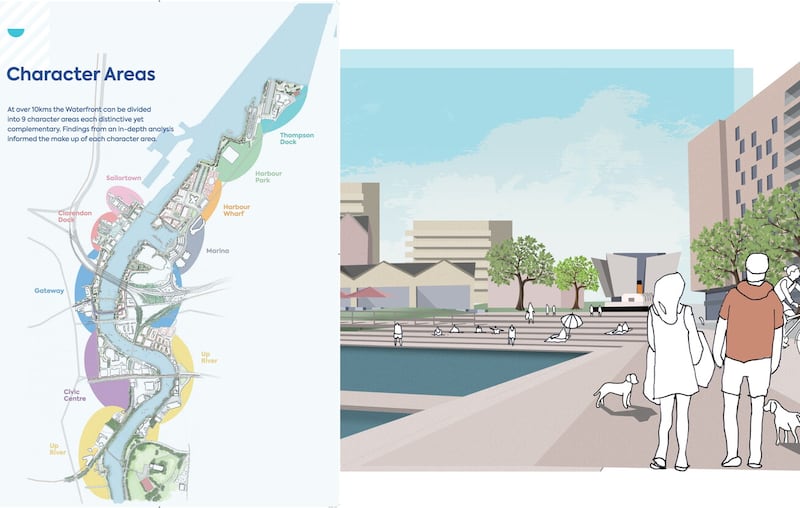SEVERAL kilometres of the River Lagan should be harnessed as part of a 30 year plan to reimagine Belfast’s waterfront areas, a new study has outlined.
Styled as Belfast Waterfront Promenade, the new framework document launched on Thursday states that of the 10km of waterfront area between Sailortown and Ormeau Park, more than half remains available for development.
Danish urban designers Schulze+Grassov were commissioned by Belfast’s Waterfront Task Group to develop a framework to ensure future regeneration of waterfront areas follow an agreed set of design principles.
They said the project is an important opportunity to encourage and harmonise new sustainable development on the waterfront.
Their study includes practical design guidance and a 'toolkit' of development options to help balance community, nature, and development.
There are plans for new pedestrian and cycle bridges across the Victoria Channel, as well as new public spaces, playgrounds, heritage trails, floating boardwalks, businesses and wetlands, moorings and cantilevered decking.
The framework also maps nine ‘character areas’ on either side of the Lagan bank, from the harbour area (Thompson Dock, Harbour Park, Harbour Wharf, Marina, Sailortown and Clarendon Dock) toward the city centre areas, labelled as ‘Gateway’ and ‘Civic Centre’. The ninth area is simply classed as ‘Up River’.
Belfast’s Waterfront Task Group consists of major landowners and government bodies, including Belfast Harbour, Belfast City Council, Maritime Belfast, Titanic Quarter Limited, Tourism NI and four Stormont departments.
The chief executive of the Maritime Belfast Trust, Kerrie Sweeney, said while significant work had been undertaken around the harbour area over the past 30 years, large waterfront areas of Belfast have yet to be regenerated.
“We’re ready for the next stage, but this generational opportunity will only realise its full potential if everyone adopts a joined-up approach,” she said.
“The promenade framework, backed by all the key groups involved in Belfast’s waterfront, is the starting point for the next 30 years of development.
“It won’t happen overnight, but there’s no reason why Belfast can’t be a great people-centric waterfront city on par with locations such as Copenhagen, Stockholm or Seattle.”

Oliver Schulze is co-founder of Schulze+Grassov, wohose portfolio includes Berlin’s Potsdamer Platz and London’s Design District in Greenwich.
“Belfast is world famous for its shipbuilding heritage, but few people – internationally or even in Northern Ireland – really appreciate how long the city’s waterfront is and its proximity to the city centre - or the stunning backdrop of the Belfast Hills,” he said.
“These natural advantages help make this remarkable urban space internationally significant. The framework aims to build upon these elements and create a shared sense of place to link and enhance future development projects.”


